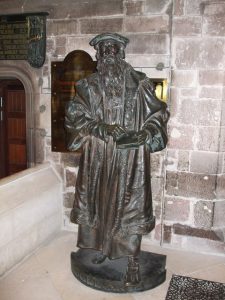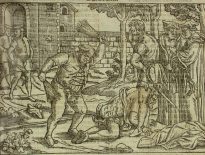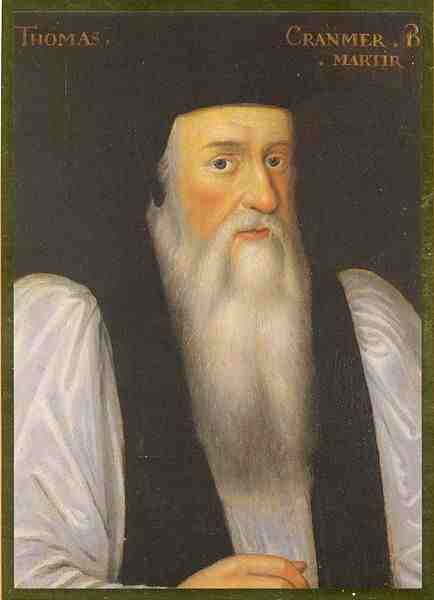 On 24th November 1572, the Scottish clergyman, famous Reformer and founder of Presbyterianism, John Knox, died at his home in Edinburgh as his wife read aloud from Paul's First Letter to the Corinthians. He was buried in the cemetery of St Giles’ Cathedral, Edinburgh, where he had served as minister. Knox is known for bringing the Protestant Reformation to the church in Scotland.
On 24th November 1572, the Scottish clergyman, famous Reformer and founder of Presbyterianism, John Knox, died at his home in Edinburgh as his wife read aloud from Paul's First Letter to the Corinthians. He was buried in the cemetery of St Giles’ Cathedral, Edinburgh, where he had served as minister. Knox is known for bringing the Protestant Reformation to the church in Scotland.
Here are some details about his life and works from Claire's book On This Day in Tudor History:
John Knox was born in c.1514 at Giffordgate in Haddington and was the son of William Knox, whose family had served the Earls of Bothwell for many years. John studied at St Andrews University under John Mair before entering the Church.
It is not known when Knox became a Protestant, but he was good friends with George Wishart, who was burned at the stake for his Protestant faith in 1546, and was influenced by Heinrich Bullinger and John Calvin, whom he met while in exile in Geneva during Mary I's reign.
Knox's works include A Faithful Admonition unto the Professors of God’s Truth in England (1555), which was an attack on the Catholic Mary I and her regime - click here to read more about it, and his famous The First Blast of the Trumpet Against the Monstrous Regimen of Women (1558), in which he attacked women rulers such as Mary I and Mary of Guise.
In early August 1560, Knox was involved in drawing up the Scots Confession, which was approved by Parliament who also abolished the jurisdiction of the Pope in Scotland, forbade the celebration of mass, condemned doctrine and practice which did not adhere to the reformed faith, and asked Knox and other Reformist ministers to organise the new Scottish Kirk (church). Knox and his fellow ministers drew up the “Book of Discipline”, but Parliament delayed overruling on it because Mary, Queen of Scots was due to come back to Scotland. Over the next three years, Knox was summoned into Mary's presence five times, accused of inciting rebellion and speaking against her. He was lucky to escape charges of treason.
After Lord Darnley’s Protestant supporters murdered Mary’s secretary, David Rizzio, in March 1566, Knox fled to Kyle in Ayrshire where he worked on his “History of the Reformation in Scotland”. Darnley’s subsequent murder and Mary’s marriage to Bothwell, the chief suspect in Darnley’s murder, led to divisions in the Protestant nobles as they tried to figure out what to do. Mary was eventually forced to abdicate and was imprisoned in Loch Leven Castle, while James Stewart acted as regent for Mary’s infant son, James VI. On 29th July 1567, John Knox preached in Stirling at the coronation of James VI, and started preaching against Mary, even pushing for her execution. On 23rd January 1570, James Stewart was assassinated, and his successor, Matthew Stewart, 4th Earl of Lennox, was shot dead a year later. On 30th April 1571, all enemies of the Queen were ordered by the controller of Edinburgh to leave the city. However, Knox knew the controller, and so was offered the option of staying in Edinburgh as a captive in the castle. Knox refused this offer and left the city on the 5th May to travel to St Andrews. After the truce of July 1572, he was able to return to Edinburgh and he preached there, at St Giles, until his death.
Picture: Statue of John Knox inside St Giles' Cathedral, Edinburgh, Photo © ronnie leask (cc-by-sa/2.0)



I have no good thoughts at all about John Knox, sorry, because of his personal attacks on Mary from the moment she came home. He was a loud, obnoxious and intolerant man, who hated women. Mary was right to charge him with inciting a riot because leading a mob through the streets to shout and rant because the Queen was saying Mass in her private chapel, is doing just that. She wasn’t forcing or even trying to force her faith on anyone and in her confrontation with Knox she gave better arguments than his ranting. I am sure he was passionate about his beliefs but he didn’t represent a loving God very well, he was full of fire and hatred and he was also attacking her authority. Mary’s later personal reputation because of her involvement with James Hepburn, Lord Bothwell made her out to be a wh*re, but it was Knox and his mob who fired people up, without even finding out the truth, which was she was abducted, raped and forced into marriage with him. He was accused of her husband, Henry, Lord Darnley’s murder and Mary maybe could have called for his trial, but in reality I don’t think she had much choice. I think Knox made everything worse and is responsible for her downfall. He wasn’t very polite about Elizabeth I or Mary Tudor either and his reputation as a woman hater has taken over anything good he may or may not have to say.
Having said this a visit to his house in Edinburgh and his church does show something of the human being and some of his personal things give a link to a man who was actually quite troubled at times and struggled with his own mind. He could also be quite sensitive, which actually surprised me. John Knox certainly changed Scotland and his influence was very strong. There are strong links between Scotland, Ireland, Switzerland and Germany because of Knox. His philosophy was not just a religious one but a very strong moral one, with rules to correct every aspect of behaviour. I can’t imagine him being much fun.